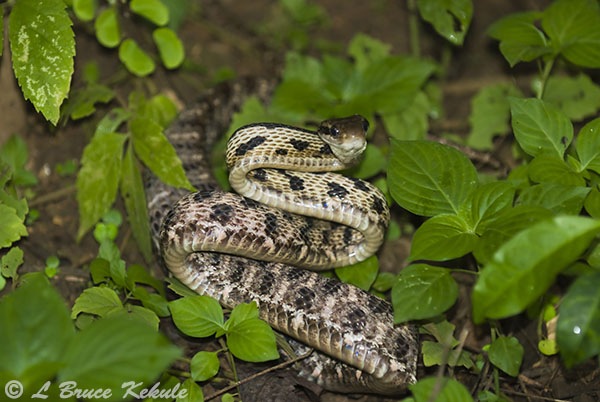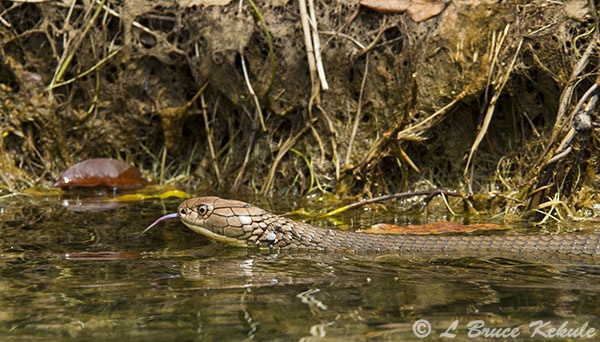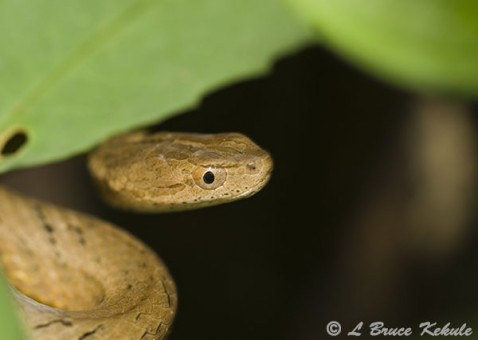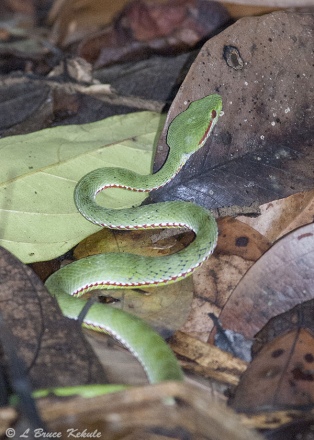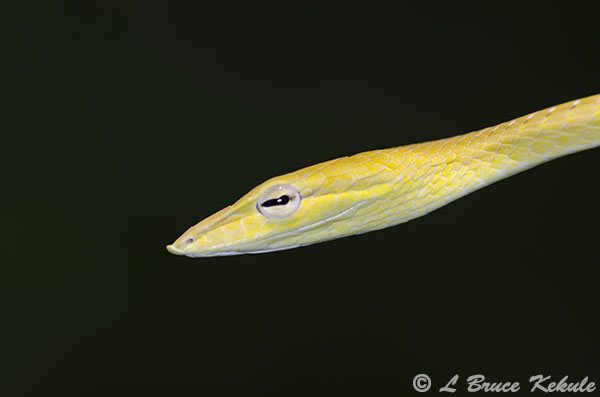Snakes Alive: Thailand’s limbless reptiles
Feared by most but revered by some: More than 217 species in the Kingdom
King cobra hunting by the Phetchaburi River in Kaeng Krachan National Park.
A magnificent serpent some five meters in length slides along the forest floor looking for another reptile to eat. Its movement is swift but steady. Senses are on high alert as a rat snake moves ahead. The big snake rears up and strikes pumping venom into the smaller one. The two wrestle for a short while but soon it is all over as the ‘King’ swallows the lifeless victim headfirst.
Such is the life of the king cobra Ophiophagus hannah, the largest venomous snake in the world. Their main objective in life is to kill other snakes, eat them, and to propagate keeping the species intact. These cobras live primarily in pristine forest far from human interference. They are rarely seen being highly elusive but chance encounters do happen.
The same cobra just before it made a U-turn into the forest.
Over the years, I have bumped into these fearsome snakes several times. My first encounter was while working in Kaeng Krachan National Park along the Phetchaburi River in the Southwest. One day while trekking up-river, my team and I were about to turn back when a large dark snake appeared some 10 meters away.
I quickly brought my camera up and shot a series of images as the creature slid by. After using the flash, it did a U-turn and disappeared into the forest. The team had already retreated leaving me to my own devices. It certainly was a heart-stopper but worth every second of the encounter collecting these photographs.
Reticulated python on the road in Khao Ang Rue Nai Wildlife Sanctuary
Years later while working around the Chiew Larn reservoir in Khlong Saeng Wildlife Sanctuary situated in Surat Thani province down South, I was silently motoring along in my battery powered boat-blind when a king cobra swam in front of the craft.
Immediately recognizing it, I decided to give chase but the long big snake was faster and got to the opposite shoreline first. I then steered the boat diagonally to catch up with it moving along the bank. Its head appeared over a log and it rose up with hood expanded about eight meters away scaring the life out of me.
Siamese cat-snake in Thung Yai Naresuan Wildlife Sanctuary
It surely looked mighty big through the lens and I quickly reversed the motor to escape. Being in a boat and constantly moving, all my shots were slightly out of focus. The encounter was brief and disappointing, but I was relived when the highly poisonous reptile slipped away into the dense foliage.
The next day with my team in a bigger boat, another king cobra crossed in front of us. This snake was busy hunting and gave us no heed. We hung back as I fired off a whole bunch of photos through my camera and 500mm long lens. Then the young snake climbed up a tree and eventually disappeared. This particular king cobra had ticks attached to its head. These reptiles are excellent swimmers but also climb very well while hunting, and contrary to popular belief they only stay on the ground.
King cobra hunting in Khlong Saeng Wildlife Sanctuary
Thailand has approximately 217 snake species recorded so far (as of early 2012). There are eleven families and many sub-families and genus. A third are highly poisonous, another third mildly venomous and the remaining third are non-poisonous. It is safe to say that snakes – arboreal, aquatic or fossorial (borrowing) can be encountered in every possible habitat, from paddy fields all the way up to montane forest plus urban sprawl, mangroves and the sea.
The same cobra climbing. Note the big tick on its neck.
At the last species count, there are four cobras, 16 vipers, three pythons, three kraits, nine cat snakes, four whip snakes, four rat snakes, 20 keelbacks, 29 sea snakes, 11 blind snakes, 14 water snakes and 13 wolf snakes. There is also a sunbeam snake, a pipe snake, a file snake and four slug snakes. These range from a few centimeters to giants that can exceed 10 meters like a mature reticulated python.
Biologist will argue over snake classification for a long time to come as new species are discovered all the time. Doing research on snakes has been carried out at many universities and institutes in the Kingdom.
Green-bellied pit viper in Kaeng Krachan
Probably some of the best research was undertaken by the late Dr Jarujin Naghitabhata (1950-2008) who was instrumental in establishing the National Science Museum and the Museum of Natural History in Khlong Luang north of Bangkok.
He was a walking dictionary, not only on snakes but all the other reptiles and amphibians plus birds, insects, terrestrial mammals and bats. Jarujin published many books, journals and papers on all the above. He was a kind man and his passing is a great loss for the country.
Yellow bellied pit viper and carpenter ant in Kaeng Krachan
I certainly will miss our friendship as he helped me identify many species for my book projects. However, his work continues today with all his students and protégés at the museum. It is definitely worth the trip out there especially for the kids to see all the amazing things that can be found in the natural world.
It is a fact that most people fear and dislike snakes, and that perpetuates widespread misunderstanding about these cold-blooded creatures. Once the fear of snakes can be overcome, their beauty and grace will become apparent and appreciated.
A mock viper in Doi Inthanon National Park
Snakes rarely attack unless seriously provoked. Tongue flickering of many reptiles is not aggression but simply transmitting signals to their organs of smell. Cobras spread their hood demonstrating an aggressive posture when threatened. Vipers coil-up ready to strike hanging motionless from a tree branch or on the ground. Pythons kill by restricting their prey before devouring headfirst.
Unfortunately, many snakes are caught and eaten. Others are killed outright and left to rot. Snakes are very important creatures for pest control and should be treated with respect. They keep rats and mice in check. Fatal bites do occur but with modern snake antivenins ready availability in hospitals, fatalities are few and far between.
A pit viper on the forest floor in Kaeng Krachan
I know a man who jumped off a boat on Phi Phi Island in the Andaman Sea with just flip-flops and got bitten by a pit viper. After stepping on the little snake, it struck three times injecting its venom into his foot. His was lucky as the Thai Navy flew him by helicopter to a hospital in Phuket and then on to Bangkok where doctors managed to save his foot and life. I also know of a hunter in the Eastern forests who was attacked by a king cobra – he was found three days later black from the torso up – obviously he did not survive.
Occasionally, a large mature python will take a human, mostly is areas adjoining the forest where these monsters live. I know of a tree in the Western Forest Complex that was famous for taking out sitting poachers until the locals finally got wise and stopped. The men just disappeared leaving their guns and stuff on the platform.
A cave-dwelling snake in Sai Yok National Park
Over the years, snakes were captured and exported for the pet trade, and many species went into decline. Fortunately, the Thai government stopped exporting snakes and possibly some species have made a slight comeback. However, illegal operators still manage to break the law shipping reptiles to other Asian countries for local consumption.
All the pythons, the king cobra and a few rat snakes are now protected by law, but most are not including the other cobras and vipers. The future of snakes depend on large-scale public awareness programs for the need to educate the public, spare any found and make sure that illegal wildlife traders are apprehended and put away. This of course will be a tough nut to crack as these people seem to carry-on with impunity, and the markets are ever expanding.
A whip snake in Huai Kha Khaeng Wildlife Sanctuary
If certain steps are taken by the authorities to counter habitat loss and combat wildlife traders, only then can we say the limbless reptile will continue to survive in good numbers. These amazing creatures certainly need our help.





